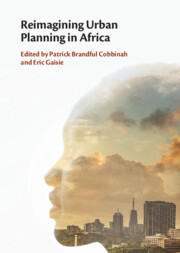Book contents
- Reimagining Urban Planning in Africa
- Reimagining Urban Planning in Africa
- Copyright page
- Contents
- Contributors
- Foreword
- Preface
- Acknowledgements
- Abbreviations
- Part I Understanding Sustainable Urban Planning in Africa
- Part II Case Studies on Urban Planning in African Countries
- 7 The Proliferation of Gated Communities
- 8 History, Practices, Challenges and Opportunities of Urban Planning in Zimbabwe
- 9 The Evolution and Nature of Urban Planning in Nigeria
- 10 Rethinking Urban Planning and Informal Settlement Upgrading
- 11 Urban Planning Challenges and Slum/Informal Housing Formation in Ogun State, Nigeria
- 12 The Proliferation of Slums in Cameroon
- 13 An Overview of Urban Planning in Tanzania
- Part III Sustainable Urban Planning in Africa
- Index
- References
8 - History, Practices, Challenges and Opportunities of Urban Planning in Zimbabwe
from Part II - Case Studies on Urban Planning in African Countries
Published online by Cambridge University Press: 07 December 2023
- Reimagining Urban Planning in Africa
- Reimagining Urban Planning in Africa
- Copyright page
- Contents
- Contributors
- Foreword
- Preface
- Acknowledgements
- Abbreviations
- Part I Understanding Sustainable Urban Planning in Africa
- Part II Case Studies on Urban Planning in African Countries
- 7 The Proliferation of Gated Communities
- 8 History, Practices, Challenges and Opportunities of Urban Planning in Zimbabwe
- 9 The Evolution and Nature of Urban Planning in Nigeria
- 10 Rethinking Urban Planning and Informal Settlement Upgrading
- 11 Urban Planning Challenges and Slum/Informal Housing Formation in Ogun State, Nigeria
- 12 The Proliferation of Slums in Cameroon
- 13 An Overview of Urban Planning in Tanzania
- Part III Sustainable Urban Planning in Africa
- Index
- References
Summary
The British colonisers introduced urban planning in Zimbabwe in 1890. The 1933 Planning Act, situated largely in the realities of Britain at the time, institutionalised planning as a practice for adoption by urban local authorities. The legislation was amended in 1945 to embrace changes noted in the countryside so that it became a Town and Country Planning Act. Noticing that some of the developments were exceeding one district, in 1976 the Planning and Country Act was revised to become the Regional, Town and Country Planning Act. It was revised in 1995 and still retains the title. The legislative instrument guides planning practice, directing regional, master and local planning. It covers aspects of development control, subdivision and consolidation. It would appear that all was going well until the practice began to be challenged in the 2000s, as retaining colonialist rigidity made development cumbersome if the necessary approvals were not in place. The 2005 Operation Murambatsvina was perhaps one of the worst human disasters in the land, with the planned city displacing the poor. A host of challenges exist, yet opportunities are there to improve planning in Zimbabwe.
- Type
- Chapter
- Information
- Reimagining Urban Planning in Africa , pp. 131 - 142Publisher: Cambridge University PressPrint publication year: 2023



